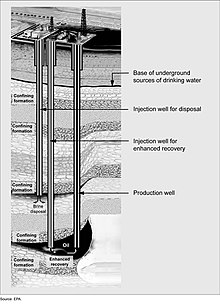Produced water

Produced water is a term used in the
As an oilfield becomes old, its natural drive to produce hydrocarbons decreases leading to decline in production. To achieve maximum
Water quality
The water composition ranges widely from well to well and even over the life of the same well. Much produced water is
Water management

Water is required for both traditional geothermal systems and EGS throughout the life cycle of a power plant. For traditional projects, the water available at the resource is typically used for energy generation during plant operations.[11]
Historically, produced water was disposed of in large evaporation ponds. However, this has become an increasingly unacceptable disposal method from both environmental and social perspectives. Produced water is considered industrial waste.
The broad management options for re-use are
Gravity separators, hydrocyclones, plate coalescers, dissolved gas flotation, and nut shell filters are some of the technologies used in treating wastes from produced water.[15]
Radioactivity
The use of produced water for road deicing has been criticized as unsafe.[16]
In January 2020, Rolling Stone magazine published an extensive report about radioactivity content in produced water and its effects on workers and communities across the United States. It was reported that brine sampled from a plant in Ohio was tested in a University of Pittsburgh laboratory and registered radium levels above 3,500 pCi/L. The Nuclear Regulatory Commission requires industrial discharges to remain below 60 pCi/L for each of the most common isotopes of radium, radium-226 and radium-228.[17]
See also
- Industrial waste water treatment
- Oil–water separator
References
- S2CID 233073324.
- ^ S2CID 248019293.
- S2CID 245682408.
- S2CID 247848365.
- S2CID 244823147.
- S2CID 211080984– via Springer Nature.
- ^ "What is produced water?". American Geosciences Institute - AmericanGeoSciences.org. Retrieved December 31, 2023.
- ^ "About Produced Water". Advanced Water Technology Center. Golden, CO: Colorado School of Mines. Retrieved 2016-05-14.
- .
- ^ Veil, John A.; Puder, Markus G.; Elcock, Deborah; Redweik, Robert J. (2004). A white paper describing produced water from production of crude oil, natural gas, and coal bed methane (PDF) (Report). Argonne, IL: US Argonne National Laboratory. ANL/EA/RP-112631.
- OSTI 1013997.
- ^ "Underground Injection Control Regulations and Safe Drinking Water Act Provisions". Washington, DC: U.S. Environmental Protection Agency (EPA). 2016-10-17.
- ^ "General Information About Injection Wells". EPA. 2016-09-06.
- ^ "Oil and Gas Extraction Effluent Guidelines". EPA. 2019-05-15.
- ^ Development Document for Final Effluent Limitations Guidelines and New Source Performance Standards for the Offshore Subcategory of the Oil and Gas Extraction Point Source Category (Report). EPA. 1993. pp. IX-15–IX-19. EPA-821-R-93-003.
- .
- ^ Nobel, Justin (21 January 2020). "America's Radioactive Secret". Rolling Stone.
